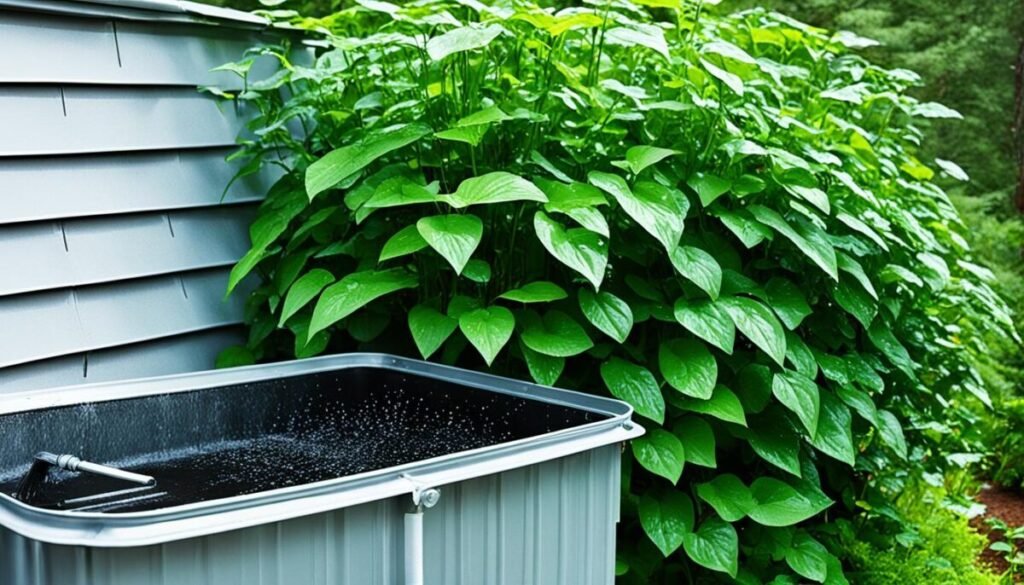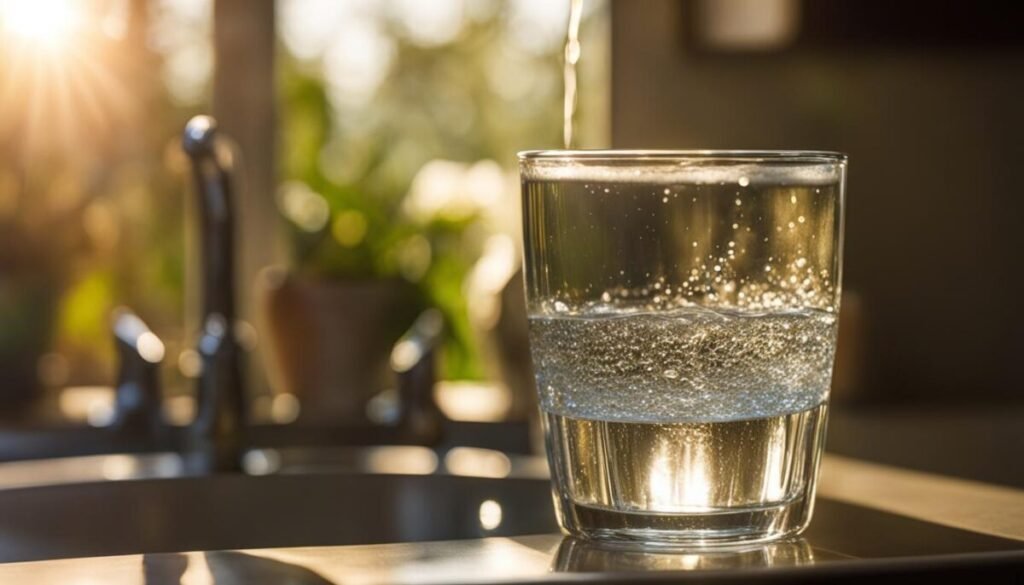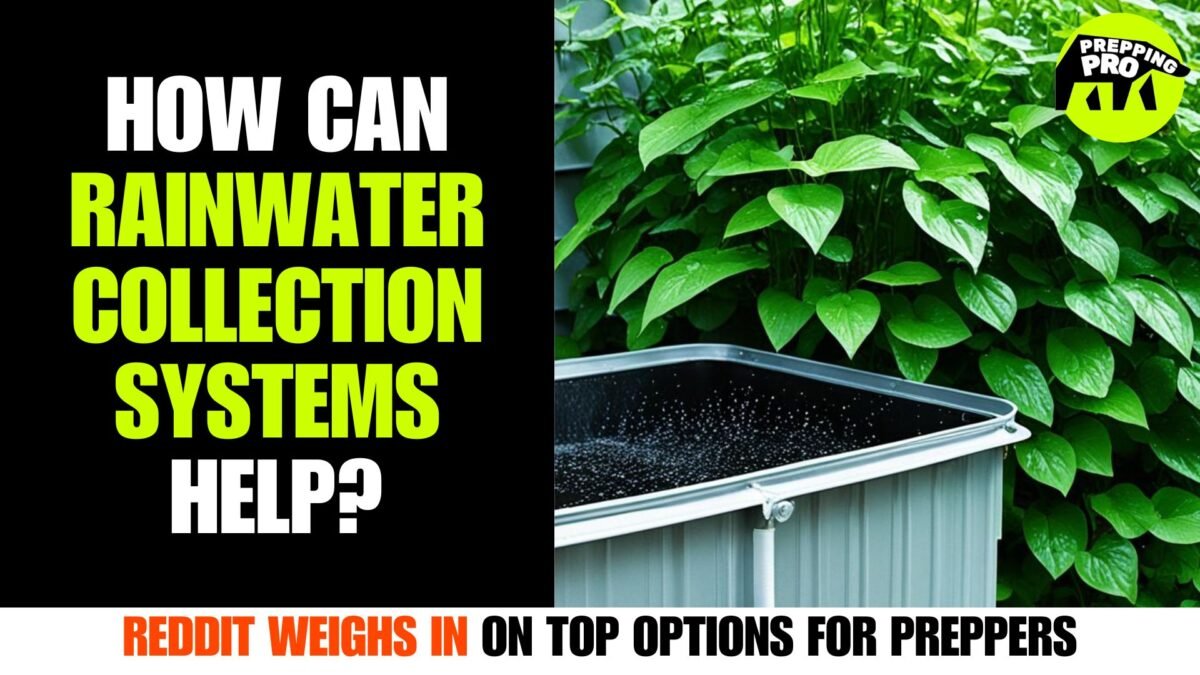In a crisis, your emergency water supply status can become a life or death factor.
In this article, we’ll examine how rainwater collection systems present sustainable water solutions to harness nature’s gift for our water security needs in times of crisis.
This discussion is critical not only for establishing a disaster preparedness water supply, but as a part of complete food and water storage.
- Types of Systems: From simple barrels under downspouts to complex underground storage.
- Uses: For irrigation, toilet flushing, outdoor cleaning, and, with treatment, drinking.
- Legal and Health Considerations: Compliance with local laws and ensuring water safety.
- Cost and Size: Can range from under $50 for DIY to over $20,000 for comprehensive home systems.
- Installation and Maintenance: Involves gutter cleaning, tank inspection, and water purification.
- Design Considerations: Includes catchment area, storage capacity, and filtration for water quality.
- Local Regulations: Vary by location, affecting system use and potability
Table of Contents
Reddit Weighs In: From Rainwater to Toilet Water
Water is a precious resource, and finding sustainable ways to harness and utilize it is a priority for many preppers.
In these case studies, we delve into the world of rainwater and greywater harvesting, as discussed by frugal and off-grid enthusiasts on Reddit.

Objective: By examining the insights and experiences shared in these threads, we aim to uncover practical tips, potential pitfalls, and innovative techniques for effectively collecting and utilizing rainwater and greywater.
Background Information
Context: The first thread, from the r/Frugal subreddit, explores the realities of rainwater and greywater harvesting from a cost-saving perspective.
The initial post sparks a lively discussion among community members sharing their personal experiences, challenges, and creative solutions.
Community Profile: The r/Frugal community consists of individuals seeking ways to live more economically and sustainably.
Their interest in water harvesting aligns with their desire to reduce utility costs and minimize waste.
Analysis of Discussion
Key Points: Across both threads, recurring themes emerge, such as the importance of proper filtration systems, legal considerations in certain regions, and the benefits of utilizing rainwater for non-potable purposes like gardening and flushing toilets.

Insights: The discussions highlight the potential drawbacks of greywater harvesting, such as the risk of bacterial growth and the need for specialized soaps.
However, many participants share successful strategies for overcoming these challenges.
Personal Stories or Quotes
Contributor Highlights:
All of our home’s water is collected rainwater – this is not uncommon in rural KY. We have a 1000-gallon tank in a room on the back of the house, and about four hundred gallons of rainbarrels connected to each other that’s mostly used for the animals and watering the garden.
Reddit User
Differing Views: While some users express concerns about the legality and potential health risks of rainwater and greywater harvesting, others argue that with proper precautions and filtration, these systems can be safe and effective.
Practical Applications

Based on the discussions, recommended practices include using mosquito pellets to prevent insect breeding in standing water, installing multi-stage filtration systems, and utilizing UV disinfection for potable water.

For those interested in implementing rainwater or greywater harvesting, users suggest starting small with a few rain barrels and gradually expanding the system as needed.

Consulting local regulations and seeking professional advice is also recommended.
Conclusion
Summary: The Reddit threads offer a wealth of information on the opportunities and challenges of rainwater and greywater harvesting.
While not a one-size-fits-all solution, these practices can potentially reduce water bills, promote sustainability, and provide an alternative water source for various household needs.
Reflection:
As a prepper, I found the discussions around rainwater and greywater harvesting to be incredibly valuable.
Water is one of the most critical resources for survival, and having alternative sources could be absolutely vital in an emergency situation.
I was impressed by the level of knowledge and experience shared by Reddit users who have implemented rainwater collection systems in their homes.
Learning from their first-hand accounts helps demystify the process and provides a roadmap for preppers looking to become more self-sufficient.
The emphasis on proper filtration and treatment resonated strongly with me.
Ensuring water is safe for consumption or other uses is paramount, so the recommendations for multi-stage filtration, UV disinfection, and careful monitoring were insightful.
I’ll be sure to prioritize these elements in any rainwater harvesting setup.
The discussions around greywater were particularly eye-opening. While it may seem unsavory at first, the ability to reuse water from showers, laundry, etc. for non-potable purposes like flushing toilets could be a game-changer in a long-term crisis.
The precautions discussed, such as using eco-friendly soaps and promptly dispersing greywater to prevent bacteria growth, provide a framework for doing so safely.
Overall, I came away from these threads feeling empowered with knowledge that could enhance my preparedness efforts.
Setting up rainwater harvesting capabilities is now a priority for creating a self-sustaining water supply. And while greywater reuse may require more caution, it’s a valuable option to have in my arsenal, especially for times when fresh water is scarce.
The willingness of this community to share insights and learn from each other is invaluable.
I’m inspired to continue researching and implementing sustainable water solutions that could ensure my loved ones and I can endure difficult circumstances with access to this critical resource.
Call to Action: Explore the original Reddit threads to gain further insights, share your own experiences, and consider implementing rainwater or greywater harvesting techniques suitable for your circumstances.
References
Source Acknowledgment: The case study draws insights from discussions in the following subreddits:
Privacy and Policy Page
For information on how we handle user data and content on our blog, please visit: https://prepping.pro/privacy-policy/
Understanding Rainwater Collection Systems for Emergency Water Supply
Rainwater collection systems for emergency water supply typically constitute of a range of essential components.
Predominantly, a roof catchment surface is utilized for the purpose of rooftop water harvesting. This surface is usually shielded with a screen to hinder any debris from contaminating the harvested water.

Furthermore, a storage container is part of the rainwater collection system. Often, this container is fabricated from BPA-free and non-transparent material in order to prevent the growth of algae.
In order to access the harvested water, an outlet is also incorporated into the system, usually in the form of a spigot.
The benefits of such rainwater harvesting systems are indeed multi-fold:
- They decrease dependency on municipal sources
- They reduce stormwater runoff
- Often cited as a free water source endorsing self-sufficiency
Modern designs of these systems are equipped with ‘first flush’ devices ensuring cleaner water, making them adaptable to new and existing structures alike.
Whether for irrigation, sanitation, or potable uses after purification, these systems prove vital in off-grid living scenarios and during the aftermath of disasters when traditional systems might fail, promoting a more self-sufficient water supply.
Key Components of a DIY Rainwater Harvesting System
Managing an emergency water collection doesn’t end with a reservoir full of rainwater or setting up large water tanks.
It’s just as crucial, if not more, to ensure this captured resource is safely usable for varied applications.
That’s precisely where multi-stage filtration systems and UV disinfection come into play. Let’s delve into their importance and functions in a DIY rainwater harvesting system.
8 Steps to Installing Multi-Stage Filtration Systems
After initial collection, the rainwater undergoes basic straining to remove large debris, which forms the first stage of filtration.
At this point, however, the water isn’t adequately clean for most uses. That’s where a multi-stage filtration system steps in.
The purpose of this system is to eradicate smaller particles that made it past the first filter.
More importantly, it also acts against potential harmful substances like heavy metals, chemicals, and even some types of bacteria. The exact filtering process may vary, but usually entails a fine screen filter, an activated carbon filter and a ceramic or sediment filter—each targeting specific impurities not caught by the previous stage.
Here’s the amenable part: multi-stage filtration units are relatively simple to install in a rainwater harvesting setup and are widely available in a range of sizes and types.
8 Step Process
Follow these steps meticulously to achieve optimal results:
- Gather Your Tools and Materials: First and foremost, have all necessary items on hand. This includes the filtration system components (fine screen filter, activated carbon filter, ceramic or sediment filter), along with any required piping, fittings, and tools. Preparation is key to a smooth installation.
- Inspect the Initial Strainer: Your rainwater has already passed through a basic straining process, but it’s imperative to check this filter’s condition. Ensuring it’s in top shape is vital for preventing larger debris from reaching the more delicate stages of your filtration setup.
- Decide on the Filtration System’s Location: Placement is crucial. Your system should be easily accessible for maintenance, positioned after the initial strainer but before the storage tank. Outdoor installations need protection from the elements to ensure longevity.
- Install the Fine Screen Filter: This is the first defense against smaller particulates. Install it in line with the flow from the initial strainer, making sure all connections are leak-proof. A secure fit is non-negotiable for the integrity of your system.
- Incorporate the Activated Carbon Filter: Follow up with the activated carbon filter to remove chemicals and odors, enhancing the water’s quality. Tight, secure connections are as critical here as they are at every step, ensuring no bypass or leakage occurs.
- Add the Ceramic or Sediment Filter: This final stage targets the minutest particles, including bacteria and microorganisms. Its placement is crucial in achieving the pristine water quality you’re aiming for.
- Test the Entire System: With everything connected, it’s time to run a comprehensive test. Look out for leaks and ensure water flows seamlessly through each filtration stage. This step cannot be overlooked — it’s essential for confirming the effectiveness of your installation.
- Establish a Maintenance Routine: Finally, devise a maintenance schedule based on the manufacturer’s recommendations. Regular upkeep, including filter cleaning and replacement, is essential for sustaining water quality and system efficiency.
By adhering to these steps, you’re setting up a robust multi-stage filtration system that will serve you well. Remember, the quality of your rainwater hinges on the effectiveness of your filtration system, so take each step seriously. Your diligence here ensures safer, cleaner water for all your needs.
UV Disinfection for Potable Water
Even with multi-stage filtration, the water might still be unsafe for drinking purposes if any pathogenic bacteria, viruses or protozoa that may cause waterborne diseases managed to persist.
Hence, further treatment is necessary. That’s where UV disinfection comes in, acting as a critical step towards ensuring potable water safety.
Using ultraviolet light, a UV disinfection unit neutralizes harmful microorganisms by altering their DNA, rendering them harmless. More significantly, unlike boiling or chemical treatment options like water purification tablets, it keeps the water’s taste and odor unaltered.
The installation is relatively straightforward, and the only maintenance typically involves annual bulb replacements.
With these two key systems in place, your tanked-up emergency water collection can serve a wider array of uses, from irrigation and indoor non-potable activities, to a ready supply of drinking water—especially significant in SHTF situations when conventional sources might fail.
It is, as they say, better to be safe than thirsty!
| Key Components | Functions | Potential Benefits |
|---|---|---|
| Multi-Stage Filtration System | Further cleansing after initial straining, eradicates smaller particles and potential harmful substances | Ensures cleaner water for diverse applications, relatively easy to install, available in various sizes/types |
| UV Disinfection | Neutralizes harmful microorganisms using ultraviolet light, crucial for ensuring potable water safety | Keeps water taste and odor unaltered, straightforward installation, low maintenance |
Practical Application of Harvested Rainwater in Emergencies
The utility of harvested rainwater leans heavily on the principle of practical needs for emergency water storage during crisis situations.
The scope of this usage is far-reaching, addressing a multitude of facets including irrigation, non-potable indoor use in toilets and for laundry, as well as potable usage with appropriate treatment.
However, the presence of standing water, whether potable or not, can become an attraction to mosquitoes, turning the valuable water reserve into a potential health risk.
It is therefore crucial to address this issue to prevent it from undermining the purpose of the harvested rainwater.
Mosquito Pellets to Prevent Insect Breeding in Standing Water
A failure to maintain the cleanliness and integrity of your water storage can quickly turn it into a breeding ground for insects like mosquitoes.
Enter mosquito pellets, a practical and manageable solution to prevent insect breeding in your rainwater storage containers.
These pellets act as an insecticide, and when distributed into the standing water, effectively target the mosquito larvae, preventing their growth without affecting the usability of the stored water.
This measure keeps the stored water beneficial, as intended, rather than turning it into a liability in a crisis situation.
Thus, in the practical application of harvested rainwater, the efficient management of potential issues such as insect breeding is as important as the collection and storage of the water itself.
| Application | Benefits | Challenges | Solutions |
|---|---|---|---|
| Irrigation | Cost-effective, Environmentally friendly | Contamination by heavy metals | Rainwater filtration systems |
| Non-potable indoor use | Reduces dependency on municipal water supply | Storage container maintenance | Regular cleaning and mosquito pellets |
| Potable use | Ensures water availability during emergencies | Quality control for suitable drinking water | Multi-stage filtration and UV disinfection |
Legal Considerations and Regulation Compliance in Rainwater Collection

Embracing rainwater collection can significantly contribute to sustainable water solutions. However, it is essential to be aware of the legal implications associated with such practices.
The legal parameters that dictate the collection and use of rainwater can vary greatly from place to place.
The Legal Landscape for Rainwater Harvesting
In the United States, legal considerations for rainwater collection are generally flexible. However, nuances exist in certain states due to historical water rights laws.
It’s crucial to be aware of the legislative environment within your state before installing a rainwater collection system.
For instance, states in the Western part of the country may impose stricter regulations due to the scarcity of water sources and the prolonged water disputes in this region.
Incentives and Support for Sustainable Water Practices
Interestingly, while some states place restrictions on rainwater collection, others actively promote and incentivize this practice.
Tax credits for rainwater harvesting are becoming increasingly common to encourage adoption of these systems.
Such incentives indicate governmental support for sustainable water practices, considering them integral to emergency planning and general sustainability.
| State | Legal Status of Rainwater Collection | Available Incentives |
|---|---|---|
| Colorado | Allowed with restrictions | None |
| Texas | Unrestricted | Tax exemptions, Rebates |
| Oregon | Unrestricted | Rebate programs |
| Virginia | Unrestricted | Tax credits rainwater harvesting |
The Historical Significance of Rainwater Harvesting
In times of disaster, reliable and accessible water supplies become incredibly invaluable.
As we take a look at history, it becomes apparent that our ancestors recognized the importance of rainwater, leveraging it to ensure their survival during times of water scarcity.
Their dependability on rainwater is mirrored in modern-day disaster preparation methodologies, showing the robustness and timelessness of these practices.
The Ancient Practices of Rainwater Harvesting
The concept of rainwater harvesting is far from new.
Archeological evidence shows that ancient civilizations, including the Romans and civilizations in the Middle East, had elaborate cistern systems in place to collect and store rainwater.
These systems bore paramount significance to these ancient people, holding the capacity to store millions of gallons of water.
The ingenuity behind these ancient rainwater cisterns was nothing short of impressive and served as a testament to their resourcefulness and resilience during times of water scarcity.
Evolution of Rainwater Catchment Systems Over Time
Over time, rainwater catchment systems have evolved significantly.
The basic designs introduced by ancient civilizations have been enhanced with sophisticated features that ensure increased water quality and ease of use.
Modern systems often include first flush devices that discard the initial rainwater run-off, which may carry the bulk of the pollutants from the air and roof surfaces.
This evolution, centered around ensuring cleaner water, showcases humanity’s unyielding efforts to optimize water resources and adapt to changing climatic conditions.
Modern Adaptations for Emergency Preparedness
Today, gone are the days when rainwater harvesting was merely an architectural feature in homes.
Instead, it has become a key aspect of disaster preparedness water supply strategies.
Modifying ancient practices to suit contemporary needs, modern rainwater catchment systems integrate seamlessly with existing infrastructures.
They are generally compact, often scaled to the size of homes or businesses. Yet, their potential value in the face of emergencies remains immeasurable, offering a reliable back-up water supply.
The resilience offered by these systems, coupled with the knowledge that we’re following in the footsteps of our ancestors, adds a renewed sense of purpose to the practice of rainwater harvesting.
As we strive towards sustainable living and preparedness, it is humbling to realize that these essential practices are as ancient as civilization itself.
Conclusion
As we find ourselves in an era that calls for sustainable water solutions and resilience against potential crises, integrating rainwater collection systems into emergency preparedness strategies has never seemed more pertinent.
This strategy not only echoes time-proven practices dating back to ancient civilizations but also presents a forward-thinking approach in building a resilient water supply.
Empowering oneself with a rainwater collection system signifies a pivotal move towards self-reliance and sustainable living.
It allows every one of us to contribute in our own little way to ensure water security during crises and play a part in the broader sustainability narrative.


